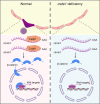The RNA-binding protein CSDE1 promotes hematopoietic stem and progenitor cell generation via translational control of Wnt signaling
- PMID: 37874038
- PMCID: PMC10652045
- DOI: 10.1242/dev.201890
The RNA-binding protein CSDE1 promotes hematopoietic stem and progenitor cell generation via translational control of Wnt signaling
Abstract
In vertebrates, the earliest hematopoietic stem and progenitor cells (HSPCs) are derived from a subset of specialized endothelial cells, hemogenic endothelial cells, in the aorta-gonad-mesonephros region through endothelial-to-hematopoietic transition. HSPC generation is efficiently and accurately regulated by a variety of factors and signals; however, the precise control of these signals remains incompletely understood. Post-transcriptional regulation is crucial for gene expression, as the transcripts are usually bound by RNA-binding proteins (RBPs) to regulate RNA metabolism. Here, we report that the RBP protein Csde1-mediated translational control is essential for HSPC generation during zebrafish early development. Genetic mutants and morphants demonstrated that depletion of csde1 impaired HSPC production in zebrafish embryos. Mechanistically, Csde1 regulates HSPC generation through modulating Wnt/β-catenin signaling activity. We demonstrate that Csde1 binds to ctnnb1 mRNAs (encoding β-catenin, an effector of Wnt signaling) and regulates translation but not stability of ctnnb1 mRNA, which further enhances β-catenin protein level and Wnt signal transduction activities. Together, we identify Csde1 as an important post-transcriptional regulator and provide new insights into how Wnt/β-catenin signaling is precisely regulated at the post-transcriptional level.
Keywords: Csde1; Hematopoietic stem and progenitor cell; Post-transcriptional regulation; RNA-binding protein; Wnt signaling; Zebrafish.
© 2023. Published by The Company of Biologists Ltd.
Conflict of interest statement
Competing interests The authors declare no competing or financial interests.
Figures







References
-
- Basak, A., Munschauer, M., Lareau, C. A., Montbleau, K. E., Ulirsch, J. C., Hartigan, C. R., Schenone, M., Lian, J., Wang, Y., Huang, Y.et al. (2020). Control of human hemoglobin switching by LIN28B-mediated regulation of BCL11A translation. Nat. Genet. 52, 138-145. 10.1038/s41588-019-0568-7 - DOI - PMC - PubMed
Publication types
MeSH terms
Substances
LinkOut - more resources
Full Text Sources
Miscellaneous

